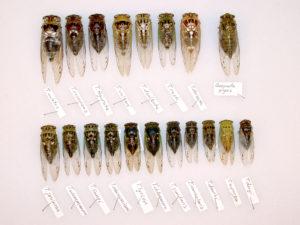Paul Krombholz has discovered some interesting variations in the Tibicen davisi cicadas. I’m quoting Paul’s email in its entirety below.
Here is the composite photo showing variation in Tibicen davisi. The
additional one I wanted to add turned out not to be as dark as I thought,
but it has a different pattern. All these came from the trees in my
backyard in central Mississippi this season. Colors on the dorsal (top)
side vary from dark brown to green. Perhaps the most typical is the “olive”
one in the middle. On the ventral (bottom) side, the black abdominal stripe
varies from very wide to non-existent. Variation in the size of the black
abdominal stripe is not related to the color on the dorsal side, as I have
seen absolutely no abdominal stripe on both a greenish one and a very dark
brown one.Davis described a variety of T. davisi—T davisi var. hardeni—which has
little or no abdominal stripe. However, it also has darkening next to the
wing veins of the seven marginal cells as in T. superbus
(http://static.flickr.com/31/60751246_f60d00e2a9.jpg?v=0), While its upper
side is “less rusty” than the typical T. davisi, its underside is also
green. (Dr. Alan Sanborn, personal communication). Since my examples only
vary as to the “greenness” of the upper side and to the size of the
abdominal stripe, none of them fit completely the description of var.
hardeni. If anyone finds a T. davisi that meets the description of var.
hardeni, I think Dr. Sanborn would like to know about it.





 Bill from Lincoln, Nebraska sent us this awesome photo of a cicada. I’ve never seen a cicada quite like this one. It’s as pretty as a butterfly. My guess is it belongs to the genus Diceroprocta, but I don’t know what species it is. Anyone know? If so, leave your guess in the comments section below.
Bill from Lincoln, Nebraska sent us this awesome photo of a cicada. I’ve never seen a cicada quite like this one. It’s as pretty as a butterfly. My guess is it belongs to the genus Diceroprocta, but I don’t know what species it is. Anyone know? If so, leave your guess in the comments section below.










